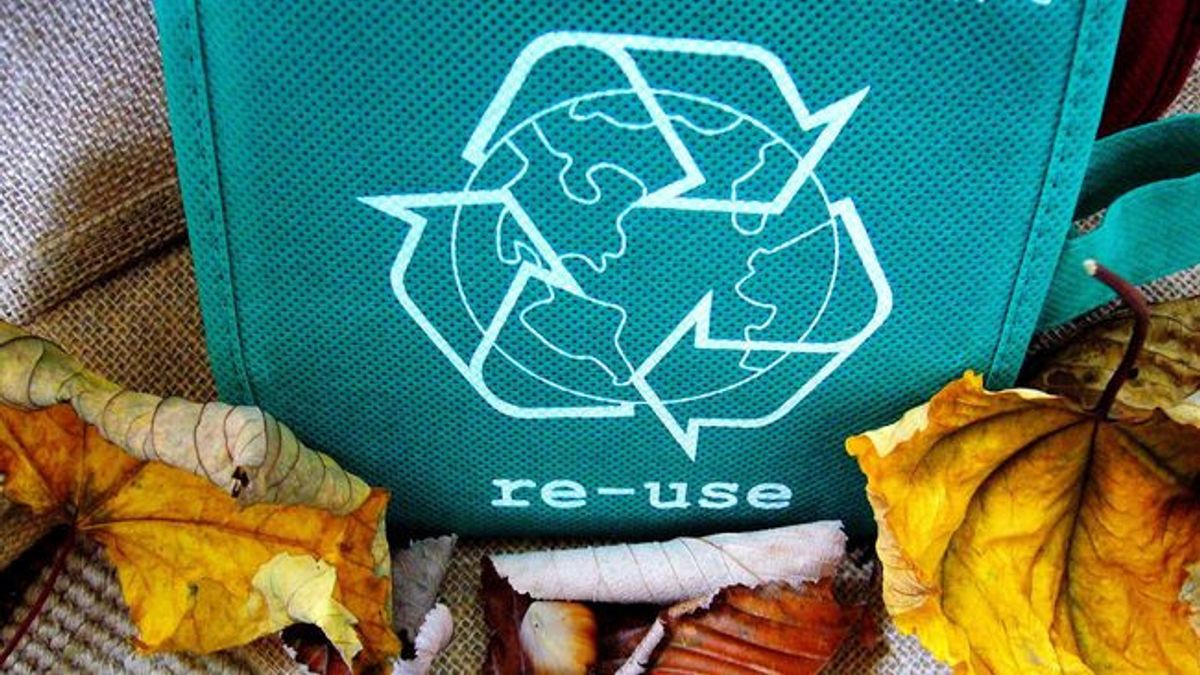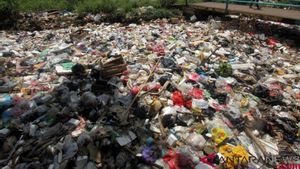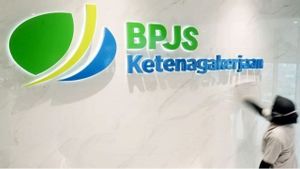JAKARTA - According to the estimation of the Indonesia National Plastic Association, every year, Indonesia produces 6.8 million tons of plastic waste. Of this amount, 9 percent or about 620,000 tons goes into rivers, lakes, and seas. The results of the LIPI research (2019) show that in Jakarta Bay, of the 8.32 tons of waste that comes in every day, 59 percent are plastic waste.
The research entitled Plastic Waste Inputs From Land Into The Ocean (2015) states, based on data analysis as of 2010 and projections by 2025, Indonesia contributes to 10 percent of plastic waste in the world's oceans.
Data from the Environment Agency (DLH) stated that the use of single-use plastic shopping bags in DKI Jakarta decreased by 82 percent after the enactment of Governor Regulation Number 142 of 2019 concerning the Obligation to Use Environmentally Friendly Shopping Bags. This figure was obtained based on the results of a survey conducted by his party with the Indonesian Plastic Bag Diet Movement (GIDKP) in December 2020, which continues to carry out surveillance in three locations, namely shopping centers, supermarkets, and people's markets. They are trying to continue to coordinate with PD Pasar Jaya to continue to push for Gubernatorial Regulation No. 142 of 2019 to be implemented properly in the market.
Quoted from Jakarta.go.id. The Head of the Waste Processing Section of the DKI Jakarta Environmental Agency, Rahmawati, acknowledged that overcoming the problem of plastic waste is a long way to go, but hopes that this regulation can create a multiplier effect, in which people will be encouraged to reduce their consumption of other plastic products, such as Styrofoam, bottled mineral water. and plastic straws. Surveys from the Environmental Service and GIDKP estimate that residents use an average of 5.2 to 6.5 tons of bags per day.

According to the Environmental Service Survey and GIDKP, it is estimated that residents use an average of 5.2 to 6.5 tons of bags per day, even though the portion of plastic bag use is actually quite small when compared to the total plastic waste which includes bottles, glasses, plastic packaging and the like.
This figure only calculates the use of crackle in the retail and market segments, not including wholesalers, packaging, food delivery packages, pharmacies, specialty stores, and others, so the total figure is estimated to be higher. But when compared to the plastic waste produced by Jakarta, the consumption of plastic bags is only 1 percent of the total plastic waste which is estimated to reach 978 tons per day.
A number of questions then arise: how much can the war on plastic bags solve the overall problem? Is the government and society's focus on plastic bags misdirected?
Education on the Prohibition of the Use of Plastic Bags
Education on the prohibition of plastic bags needs to be done so that consumers understand why they don't need to use them. Unfortunately, socialization is not carried out either from the government and business actors. Moreover, shopping for single-use plastic bags has become a habit for many Indonesians for years. So, you can't immediately switch without using plastic when shopping at traditional markets or supermarkets.
Cheap plastic is provided free of charge, used practically, the reason it is difficult for consumers to switch to other containers.

There are many regions in Indonesia, such as Jakarta, Denpasar, Sukabumi, and other regions that have made rules not to use plastic bags. Today, shops and shopping centers often offer reusable containers. A place for shopping items such as tote bags, paper bags, cloth bags, and others. Education can include, among others:
- Encouraging education to shop owners can socialize the use of plastic bags. The prohibition of using crackles must be carried out by the seller to the buyer. Not only suggesting the use of recyclable containers, but also informing the dangers of their use and the reasons for prohibiting them.
- Buyer education is important. So the socialization of plastic containers is not only targeting market traders, but it is important to do it to buyers. For example, telling can use shopping bags that are more environmentally friendly. So, consumers understand why they don't need to use plastic bags anymore.
The Importance of a Circular Economy
To overcome the problem of plastic waste, in addition to controlling its use, improving the practice of a circular economy is the solution. However, this requires an improvement in the waste collection system that immediately separates the types of waste, at least between organic and inorganic waste, so that plastic waste is easier to collect.
In addition, by increasing the number of community-based waste banks. In this way, the supply of plastic waste to the recycling industry can be increased. The circular economy is constantly being touted as a movement to overcome the problem of environmental damage.
National Geographic through the article Is A World Without Trash Possible? (18 February 2020) said, as a movement, the circular economy contains a collection of strategies that are always evolving. From reducing, reusing, and recycling strategies to renting rather than owning things. The goal is the same, namely eliminating waste so that economic growth is sustainable.

The circular economy is a new concept in economics. This concept is an update of the green economy and blue economy. In a circular economy, there are three main players, namely producers, consumers, and the recycling sector. The producer's job is to determine product designs that are durable, can be used more than once, repaired, composted, and can be recycled. The goal, goods do not just end up in landfill.
Indonesia is already running a circular economy through recycling and waste banks. The recycling business has been running through the 3R program since 2007, initiated by the Ministry of Environment, the community, and producers. However, it is not easy to socialize the program.
Recycling Industry
Based on data from the Ministry of Industry, there are currently around 600 large and 700 small industries working on plastic recycling. The investment value is estimated at IDR 7.15 trillion. The annual production capacity reaches 2.3 million tons with an added value of more than IDR 10 trillion per year.
The Indonesian Plastic Recycling Association (ADUPI) said 70 percent of the total recycled plastic products produced were exported. According to ADUPI, foreign markets are more promising with higher prices and appreciation than domestic ones
Plastic has been included in one of the targets for implementing Indonesia's circular economy along with four other types of waste, namely food, textiles, construction, and electronics. According to the Circular Economy Agenda compiled by the National Development Planning Agency (Bappenas), the circular economy has the potential to reduce plastic waste by 36 percent in 2030 compared to normal conditions in the same year.

By increasing the number of community-based waste banks, it is hoped that the supply of plastic waste to the recycling industry can be increased. The number of waste banks in Indonesia continues to increase. In 2014, according to BPS, there were only 1,172 waste banks. In 2018, the number increased fivefold to 7,488 units.
The growth rate for this sector has been quite positive over the last five years. In 2016, the growth was 4.25 percent. Then, in 2019, the figure was 7.1 percent. During the pandemic, the rate was 4.56 percent in the second quarter of 2020.
The economic concept of reducing waste and transforming it into useful products will improve the economy, as well as improve the environment. This is in line with changes in community activities during the COVID-19 pandemic.
During activities at home, waste treats waste. They make waste management a new activity while at home.
Waste processing can be in the form of simply sorting between organic and inorganic waste. Then the inorganic waste material is taken to the waste bank to be exchanged for money. There are also those who process organic waste into compost.
This small step is quite positive. Besides being able to improve the household economy through a waste bank, this action can also support economic growth.
In the report of Finland's Independence Celebration Fund (FICF) and McKinsey (2014), quoted from the Waste4change.com page, the circular economy can benefit the global economy up to 1,000 billion US dollars every year.
Homework for Indonesia is to further manage the circular economy to improve the economy. If this step is successful, the waste management sector will have the potential to support the economy, both regionally and nationally.
This is increasingly important, especially during a pandemic. The waste processing sector is quite resilient in the midst of economic contraction. In addition, the circular economy also plays a role in realizing environmental sustainability
Impact of Mass Consumption
Wihana Kirana Jaya, Professor of FEB UGM in his writing "Urgency of Circular Economy" said that one of the important products in socio-economic activities with massive use and causing waste/garbage problems is plastic. Plastic is a vital material in business (wholesale/retail) and industry because of its versatility and wide use.
For comparison, a plastic packaging weighing 18 grams can wrap around 330 milliliters of water, while a glass bottle with the same capacity can weigh up to 250 grams. Shipping heavier packaged drinks, such as glass bottles, requires more energy, produces more carbon dioxide, and costs more to ship.
Packaging with plastic can even extend the shelf life of food and beverages because of the sensory properties of plastic that can protect against bacteria, thereby reducing food waste. In the automotive industry, the composition of plastic materials reaches 50 percent with a weight of only 15 percent of the vehicle's weight so as to increase fuel efficiency.
VOIR éGALEMENT:
In the healthcare industry related to COVID-19, plastic materials are used for materials or mixtures of materials for making tools, such as respirators, face shields, goggles, hazmat clothing, and gloves. Likewise in the electronics industry, apart from being a mixed component/frame material, it can be said that all electronic products require plastic for packaging together with cardboard until it reaches consumers' hands.
Consumers of MSMEs, minimarkets, and supermarkets, especially housewives, need shopping bags, especially plastic bags for shopping and bringing their groceries home. Plastic bags like this are generally then used as trash cans.
There are more environmental and economic benefits if the recycling of plastic waste is maximized. Plastic pollution, destruction of ecosystems, and consumption of harmful substances from plastics can be avoided. Economically, recycling plastic waste will also be profitable and has the potential to develop on an industrial scale.
The English, Chinese, Japanese, Arabic, and French versions are automatically generated by the AI. So there may still be inaccuracies in translating, please always see Indonesian as our main language. (system supported by DigitalSiber.id)


















